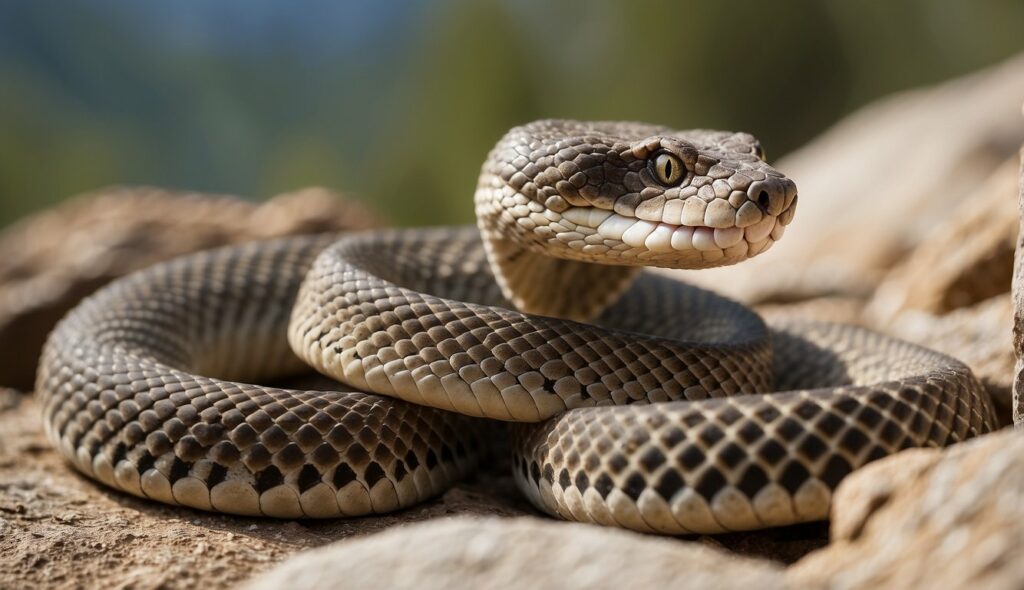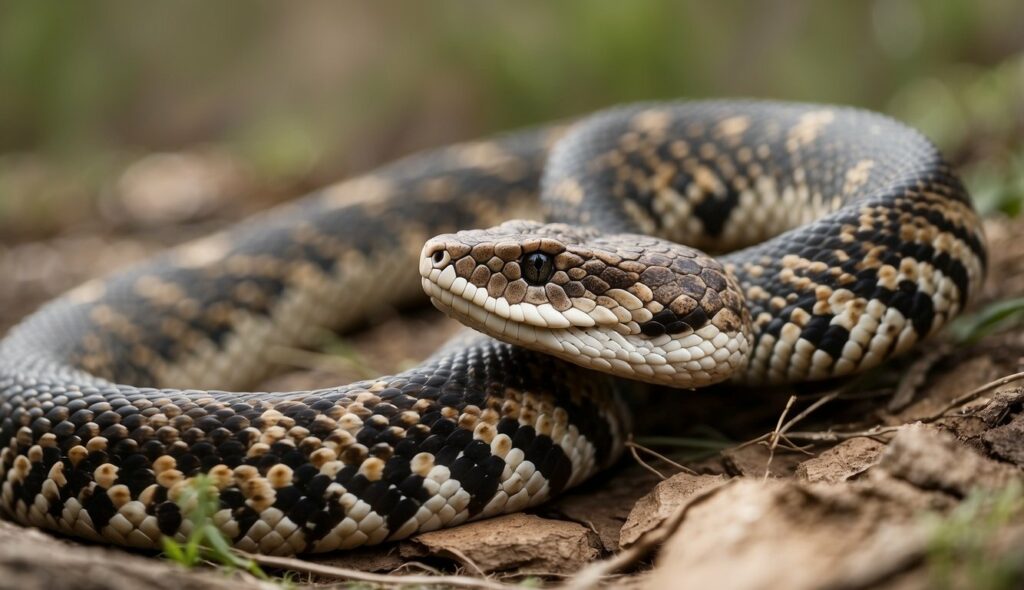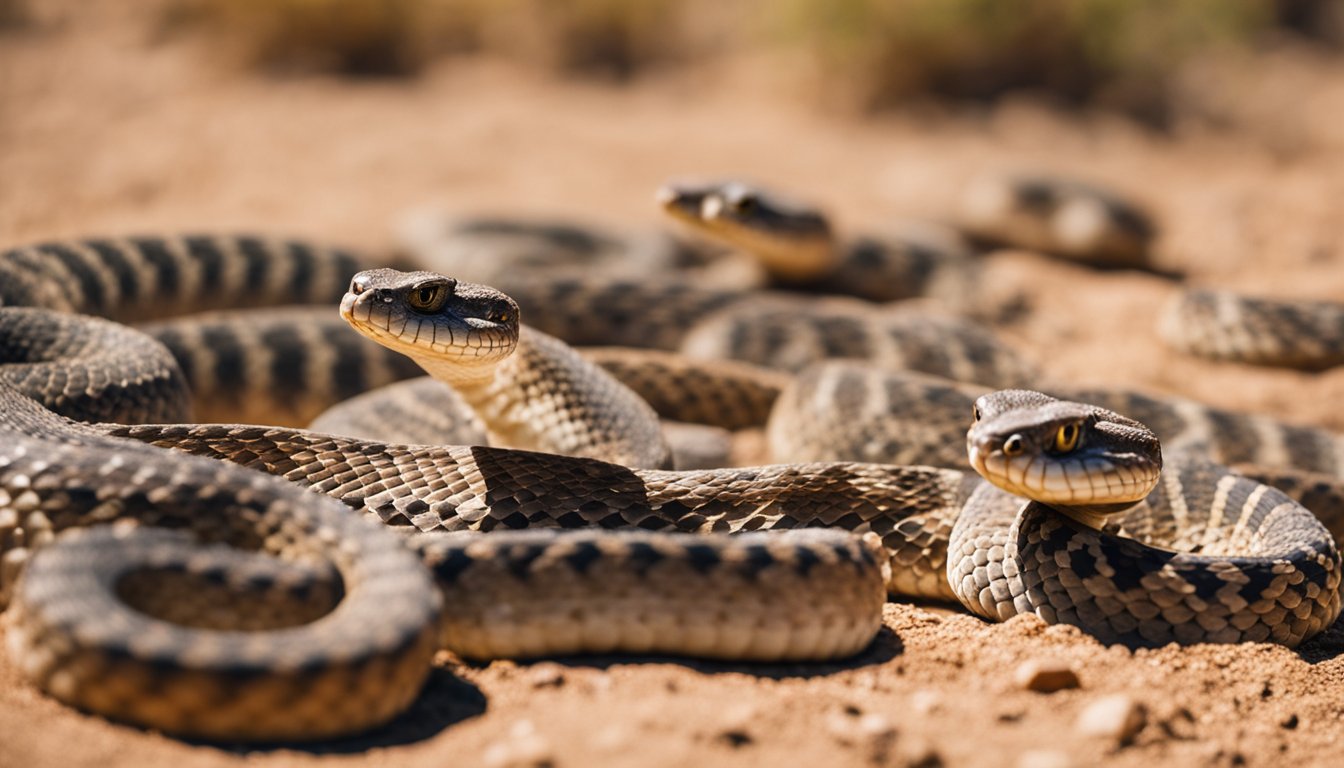Imagine walking through a sun-dappled desert, the air is warm, and the ground crunches underfoot when suddenly a distinctive sound stop you in your tracks.
That’s the sound of a rattlesnake, and it’s a signal that’s as old as time: beware.
These fascinating reptiles have captured human attention for centuries with their unique tail-shakers, but what’s the real story behind that infamous rattle?
It turns out, the rattling sound is a complex form of communication that serves as a clear warning to potential threats to stay away.

Rattlesnakes are more than their tell-tale sound; they are a critical part of the ecosystems they inhabit.
These scaly beings wield a kind of musical instrument at the end of their tails, which they’ve developed over millennia to perfect the art of defense.
Each time a rattlesnake adds a new segment to its rattle, it’s like a birthday badge, indicating another season survived in the wild.
However, this rattle doesn’t just fascinate scientists; it also plays a pivotal role in cultural stories and myths across the Americas.
Unraveling the mysteries behind these creatures gives people a glimpse into a world where every hiss and shake holds a deeper meaning.
Getting to know these snakes beyond their fearsome reputation reveals the intrinsic value they hold in nature’s complex web.
By exploring how they communicate, hunt, and survive, one can appreciate the delicate balance between predator and prey and the crucial role rattlesnakes play in maintaining healthy ecosystems.
And who knows, perhaps understanding them better will change the tune of danger into one of respect and fascination.
The Mystery of the Rattle
The rattlesnake’s rattle is not just an eerie sound; it’s a highly evolved warning system.
It’s composed of interlocking segments made of keratin and produces a chilling buzz when vibrated.
Understanding this feature reveals insights into both the behavior and biology of these fascinating reptiles.
Evolution of the Rattlesnake’s Rattle
Long ago, rattlesnakes developed their iconic rattles as a survival mechanism.
The rattle evolved to serve as an auditory signal to deter potential threats.
Most snakes rely on camouflage or fleeing to escape danger, but rattlesnakes have this additional tool.
The rattle’s evolution has been so successful that it is now synonymous with the image of a rattlesnake, signaling other creatures to stay away and avoid a possible confrontation.
Anatomy of the Rattle
The anatomy of the rattle is an intricate formation of interlocked segments.
As rattlesnakes age, they add a new segment to their rattle each time they shed their skin.
Unlike what some might think, the number of segments does not accurately tell you the snake’s age since rattles can break off.
The segments, when shaken rapidly, hit each other, creating the distinctive rattling sound.
The Sound and Its Purpose
Did you ever wonder why rattlesnakes shake their tails? It is their clever way of saying “keep distance!”
The sound of the rattle serves a clear purpose: it warns potential predators and curious creatures to back off, giving both the snake and the intruder a chance to avoid a harmful encounter.
It’s like a natural alarm system, telling everyone in the vicinity that it’s time to retreat and find somewhere safer to be.
Rattlesnake Habitat and Behavior

Rattlesnakes are fascinating creatures with striking characteristics and behaviors, adapted to a range of environments where they play the role of both predator and inhabitant.
Let’s slither into the world of rattlesnakes and uncover the secrets of where they live and how they catch their prey.
Rattlesnakes Preferred Environments
Rattlesnakes are quite choosy when it comes to their homes, typically occupying areas that provide ample sunshine and cover.
They thrive in various landscapes, from arid deserts to lush forests, and even in the rocky hillsides.
It’s not uncommon to find them basking on a sun-drenched rock or coiled in the cool shade of a bush.
These cold-blooded reptiles depend on their environment to regulate their body temperature, so they seek out spots where they can warm up or cool down as necessary.
During frigid seasons, rattlesnakes often hibernate in dens, which could be burrows abandoned by other animals or natural crevices in rocks.
Hunting Tactics Of Rattlesnakes
Now, let’s get a peek at how rattlesnakes secure their dinner.
They employ a “sit-and-wait” strategy, where they stay motionless and blend into their surroundings until an unsuspecting meal strays too close.
They have heat-sensing pits near their eyes to detect even the faintest warmth from potential prey like small mammals, birds, and lizards.
Once a target is within striking distance, the rattlesnake launches forward with lightning speed, injecting venom through its sharp fangs.
The venom is a cocktail of enzymes and proteins that immobilizes the prey.
After their prey has succumbed, rattlesnakes swallow it whole, starting with the head, using their flexible jaws to accommodate large meals.
Human Interactions and Safety

What To Do When Encountering a Rattlesnake
Picture this: you’re on a sunny trail, and ahead, there’s a rustling sound. A rattlesnake!
They aren’t looking for trouble; they’re likely just as surprised to see you.
Stay calm, give them space, and wait. Usually, they’ll rattle their tails as a polite “please stay away” before they even consider biting.
If they feel trapped, though, they might defend themselves. It’s like when you stumble upon someone unexpectedly; you might shout out of surprise.
The rattlesnake’s rattle is their way of saying, “Whoa, didn’t see you there!”
Frequently Asked Questions About Rattlesnakes

How can you tell when a rattlesnake feels threatened?
When a rattlesnake feels threatened, it makes itself known by taking a defensive posture.
They coil their bodies and raise the head in an S-shape, ready to strike if necessary.
They might also hiss as a warning, but it’s their tail that they depend on to send that clear signal of unease: the famous rattle.
What secrets do the rattles on a rattlesnake’s tail hold?
The rattles on a rattlesnake’s tail are comprised of interlocking segments made of keratin, which click together when the snake vibrates its tail.
Each time a rattlesnake sheds its skin – something they do several times a year as they grow – a new segment is added to the rattle.
In what kinds of environments would you find rattlesnakes living?
Rattlesnakes are quite versatile and can be found in various environments. They dwell in deserts, grasslands, and even forested areas.
They’re particularly fond of sunny spots where they can bask and rocky areas where they can hide easily.
Could you guess how many years a rattlesnake can slither around this earth?
Rattlesnakes may seem tough, and they are, not only due to their venomous bite but also because of their longevity.
They can live up to 20 to 30 years in the wild, which is quite impressive for a snake.
What’s the low-down on the rattlesnake’s unique rattling noise?
The unique rattling noise of a rattlesnake is a result of the snake swiftly vibrating its tail, which causes the rattle segments to knock against each other.
This can produce a sound loud enough to be heard up to 60 feet away.
It serves as a deterrent to potential threats, a way to say ‘back off’ without having to resort to biting.
What happens after a rattlesnake makes its famous rattling sound?
After a rattlesnake makes its rattling sound, it’s all about the reaction from the potential threat.
If the warning is heeded, the snake will likely retreat as well.
But if the threat persists, the rattlesnake may feel that it has no choice but to defend itself, which could lead to a venomous strike.
They rattle to avoid confrontation, not to start one.









